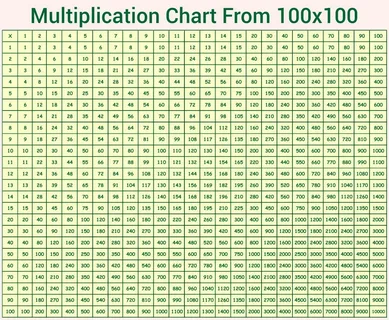Multiplication Chart 1-100: A Guide for Teachers
Table of Contents:
- Introduction
- What Is a Multiplication Chart 1-100?
- Why Is a Multiplication Chart Important?
- How to Use the Multiplication Chart 1-100
- Benefits of learning Multiplication with Charts
- Tips for Teaching Multiplication to Kids
- Fun Activities to Learn Multiplication
- FAQs About Multiplication Chart 1-100
- Final Thoughts
Introduction
Endeavoring trying to benefit your child by mastering multiplication?
You’re not the only one.
Teachers and parents alike have found explaining multiplication difficult, especially for children who are only beginning to master the concept. This is why the multiply chart 1100 can be useful.
It’s an easy instrument, but believe me when I say it will be the difference.
In this post, I’ll guide you through all you should be aware of the chart for multiplication 1-100. We’ll discuss how it functions, why it’s beneficial and some methods to help children master their time tables without stress.
What Is a Multiplication Chart 1-100?

Multiplication chart 1-100 is a Multiplication chart 1100 is an illustration grid that shows the results of multiplying numbers between 1 and 100.
It’s a sort of cheat sheet to help you master multiplication facts. On the first row, numbers and in the first column represent the number being multiplied. Depending on where the columns and rows meet, you’ll receive the result.
For instance:
- Multiply 6 times 7 and determine the place where the row 6 meets the 7 column, and you will get the result 42.
- It’s an easy way to get answers fast.
Why Is a Multiplication Chart Important?
Multiplication is a key ability in math.
Remembering times tables can be an exercise.
With the multiplication chart, 1100 children don’t need to guess or get stuck. They can look up their answers, strengthen their knowledge, and increase their confidence.
Key Benefits:
- Fast Reference Kids can find an answer for any multiplication problem within a matter of minutes.
- Visually Learning Visualizing patterns can help children understand multiplication, not just learning to do it.
- Improves confidence The chart functions as a support mechanism while they’re gaining knowledge.
- Simple to use: Even toddlers can utilize a chart of multiplication without much direction.
How to Use the Multiplication Chart 1-100
The process of teaching the child to utilize a multiplication chart is simple. Here’s how:
1. Introduce the Chart
- Let them know how the chart functions. Show them the columns and rows and exactly how they are created.
2. Start by together small numbers
- Begin by with smaller numbers, such as 1–5, to become familiar with the process.
- Example: “Let’s find 3 times 4. Take a look at the 3 rows and locate that 4 column. What do you notice? It’s 12.”
3. Practice Regularly
- Regular use is crucial. Make sure they look up the chart whenever they are doing their homework or practicing your times tables.
4. Encourage Them to memorize
- As they become more confident, push them to remember smaller pieces of information (like the 3s, 2s, 5s, or 2s tables).
- In time, they’ll depend less on charts and begin to remember the answers.
5. Use Real-World Examples
- Incorporate multiplication into your daily every day. For instance, “If we have 5 packs of pencils with 4 pencils each, how many pencils do we have in total?” Make use of the chart to figure out the answer.
Benefits of Learning Multiplication with a Chart
There are many advantages there are many benefits to using the multiplication chart 1100 to teach children. It’s much more than an easy reference tool; it helps establish the foundation of math.
Here’s Why It Works:

- Visual Learners love it for children who are more visual learners The chart demonstrates patterns and connections between numbers.
- reduces anxiety: battling with multiplication can be a frustrating experience. The chart provides children with security, which helps reduce stress and make learning more enjoyable.
- Refreshes Memory If children use the chart, if they’re with charts, they’re looking at the same answers over and over, which helps them retain the details over time.
- Promotes independence Children can utilize the chart on own, which helps build confidence as well as problem-solving knowledge.
Tips for Teaching Multiplication to Kids
Multiplication teaching can be a challenge However, with the right method, you can make it easy and enjoyable.
Here’s How:
- Make it Relatable: Make use of real-world examples such as sharing toys or snacks. This makes multiplication seem real and not an academic subject.
- Break It down: Concentration on one times table at a. Learning small pieces is much easier than learning everything in one go.
- Utilize Flashcards Flashcards are fantastic way to test your skills. Make it light and enjoyable by making it games.
- Praise progress Reward small victories. No matter if they’ve memorized the one-time table or mastered charts, praise can help keep them on track.
- Make it fun Make it fun by playing songs, games or even apps that make learning multiplication seem like a game, not a chore.
Fun Activities to Learn Multiplication
Multiplication isn’t a requirement and doesn’t need to be dull. Here are some enjoyable ways to help the child learn their tables of times:
1. Multiplication Bingo
- Make bingo cards using multiplication questions, and the answers are the numbers that appear on the cards.
- Make sure you call out the multiplication facts and have your child mark the correct answer if they have the answer on a card.
2. Flashcard Race
- Make use of flashcards to test your knowledge of multiplication. Watch how fast your child is able to solve each question, and then ask the child to break their personal record.
3. Multiplication Songs
- There are many catchy songs that help children learn their times tables. Join in and incorporate it into your routine.
4. Multiplication Apps
- Make use of educational apps that transform multiplication into games. This adds a technological twist to the learning process and keeps it interesting.
FAQs About Multiplication Chart 1-100

Q: When is the right time for children to begin with a chart of multiplication?
A: Most children begin learning about multiplication at the age of 7 to 8. A chart for multiplication can be introduced at this time to help children become comfortable with the notion.
Q: Should my child be able to remember this entire table?
The answer is yes. It’s always a great idea to teach children the basic tables of times (like the 2-12). The chart is an effective tool for them while they’re still learning. It can also be utilized as a reference in case they’re unable to remember something.
Q: What is the desirable time to utilize the chart for multiplication in conjunction with my son?
A The chart should be used daily at the time of homework or when they’re working on multiplication. With time, they’ll get more proficient and won’t require the chart as often.
Q: Do multiplication charts benefit with division as well?
A: Absolutely. Once children understand multiplication, they can utilize this chart in order to reverse their process and begin learning division.
Final Thoughts
The Multiplication Chart 1-100 is a basic but effective method for teaching children multiplication.
It relieves pressure from memory and makes learning more enjoyable and visual.
If you’re a parent who is helping the child in their home or teachers instructing students in class, the multiplication chart should be a great source.
Continue to practice, be patient, and in time enough it will be an automatic process for your child.




